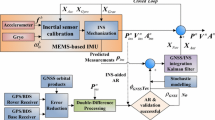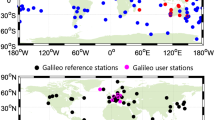Abstract
The regional constellation of BeiDou navigation satellite system (BDS) has been officially in operation since December 27, 2012, and real-time kinematic positioning using BDS and GPS multi-frequency observations is feasible. A heavy computational problem arises when resolving ambiguities in the case of multi-system with multi-frequency observations. A multi-carrier fast partial ambiguity resolution strategy is developed with the property that the extra-wide-lane and wide-lane ambiguities in the multi-frequency case can be resolved reliably in advance. Consequently, the technique resolves ambiguities sequentially instead of the usual batch ambiguity resolution (AR) mode so as to improve the computational efficiency of AR significantly. The strategy is demonstrated with real BDS/GPS dual- and triple-frequency observations. The results have shown that the probability of correct AR by the proposed method is comparable to that of the batch AR. Experimentally, the new method is about 2.5 times as fast as the batch AR in the dual-frequency case, 3 times in the mixed dual- and triple-frequency case and 3.5 times in the triple-frequency case.





Similar content being viewed by others
References
Chang XW, Yang X, Zhou T (2005) MLAMBDA: a modified LAMBDA method for integer least-squares estimation. J Geod 79(9):552–565
Euler HJ, Schaffrin B (1991) On a measure for the discernibility between different ambiguity solutions in the static-kinematic GPS-mode. In: IAG symposia no. 107, kinematic systems in geodesy, surveying, and remote sensing. Springer, New York, pp 285–295
Feng Y (2008) GNSS three carrier ambiguity resolution using ionosphere-reduced virtual signals. J Geod 82(12):847–862
Forssell B, Martin-Neira M, Harris RA (1997) Carrier phase ambiguity resolution in GNSS-2. In: Proc. of ION GPS-97, 16–19 September, Kansas City, MO, pp 1727–1736
Hatch R, Jung J, Enge P, Pervan B (2000) Civilian GPS: the benefits of three frequencies. GPS Solut 3(4):1–9
He H, Li J, Yang Y, Xu J, Guo H, Wang A (2013) Performance assessment of single- and dual-frequency BeiDou/GPS single-epoch kinematic positioning. GPS Solut. doi:10.1007/s10291-013-0339-3
Jazaeri S, Amiri-Simkooei AR, Sharifi MA (2012) Fast integer least-squares estimation for GNSS high-dimensional ambiguity resolution using lattice theory. J Geod 86(2):123–136
Jazaeri S, Amiri-Simkooei A, Sharifi MA (2013) On lattice reduction algorithms for solving weighted integer least squares problems: comparative study. GPS Solut. doi:10.1007/s10291-013-0314-z
Ji S, Chen W, Zhao C, Ding X, Chen Y (2007) Single epoch ambiguity resolution for Galileo with the CAR and LAMBDA methods. GPS Solut 11(4):259–268
Jung J (1999) High integrity carrier phase navigation for future LAAS using multiple civilian GPS signals. Proc. of ION GPS-1999, Institute of Navigation, Nashville, Tennessee, Alexandria, pp 14-17
Li B, Teunissen PJG (2011) High dimensional integer ambiguity resolution: a first comparison between LAMBDA and Bernese. J Navig 64:S192–S210
Li B, Feng Y, Shen Y (2010) Three carrier ambiguity resolution: distance-independent performance demonstrated using semi-generated triple frequency GPS signals. GPS Solut 14(2):177–184
Li J, Yang Y, Xu J, He H, Guo H, Wang A (2013) Performance analysis of single-epoch dual-frequency RTK by BeiDou navigation satellite system. In: Sun J et al (eds) China satellite navigation conference (CSNC) 2013 proceedings, vol 245., Lecture notes in electrical engineeringSpringer-Verlag, Berlin, pp 133–143
Teunissen PJG (1995) The least-squares ambiguity decorrelation adjustment: a method for fast GPS integer ambiguity estimation. J Geod 70(1–2):65–82
Teunissen PJG (1998) Success probability of integer GPS ambiguity rounding and bootstrapping. J Geod 72(10):606–612
Teunissen PJG (1999) An optimality property of the integer least-squares estimator. J Geod 73(11):587–593
Teunissen PJG (2004) Penalized GNSS ambiguity resolution. J Geod 78(4–5):235–244
Teunissen PJG (2005) GNSS ambiguity resolution with optimally controlled failure-rate. Artif Satell 40(4):219–227
Teunissen PJG, Verhagen S (2009a) GNSS carrier phase ambiguity resolution: challenges and open problems. In: Sideris MG (ed) Observing our changing earth, international association of geodesy symposia 133. Springer, Berlin, pp 785–792
Teunissen PJG, Verhagen S (2009b) The GNSS ambiguity ratio-test revisited: a better way of using it. Surv Rev 41(312):138–151
Teunissen PJG, Joosten P, Tiberius CCJM (1999) Geometry-free ambiguity success rates in case of partial fixing. Proc. of ION-NTM, 1999, 25–27 January. San Diego, CA, pp 201–207
Tiberius C, Pany T, Eissfeller B, Joosten P, Verhagen S (2002) 0.99999999 confidence ambiguity resolution with GPS and Galileo. GPS Solut 6(1–2):96–99
Verhagen S, Teunissen PJG (2013) The ratio test for future GNSS ambiguity resolution. GPS Solut 17(4):535–548
Vollath U (2004) The factorized multi-carrier ambiguity resolution (FAMCAR) approach for efficient carrier-phase ambiguity estimation. Proc. of ION GNSS 2004, 21–24 September. Long Beach, CA, pp 2499–2508
Vollath U, Birnbach S, Landau H (1998) Analysis of three carrier ambiguity resolution (TCAR) technique for precise relative positioning in GNSS-2. Proc. of ION GPS 1998, pp 417–426
Yang Y, Li J, Xu J, Tang J, Guo H, He H (2011) Contribution of the Compass satellite navigation system to global PNT users. Chin Sci Bull 56(26):2813–2819
Acknowledgments
This work is funded by the National Natural Science Funds of China (Grant Nos. 41020144004; 41374019; 41104022), the National ‘‘863 Program’’ of China (Grant No: 2013AA122501) and the 3rd China Satellite Navigation Conference (Grant No. CSNC2012-QY-3). The authors also appreciate two anonymous reviewers for their valuable comments and improvements to this manuscript.
Author information
Authors and Affiliations
Corresponding author
Rights and permissions
About this article
Cite this article
Li, J., Yang, Y., Xu, J. et al. GNSS multi-carrier fast partial ambiguity resolution strategy tested with real BDS/GPS dual- and triple-frequency observations. GPS Solut 19, 5–13 (2015). https://doi.org/10.1007/s10291-013-0360-6
Received:
Accepted:
Published:
Issue Date:
DOI: https://doi.org/10.1007/s10291-013-0360-6




